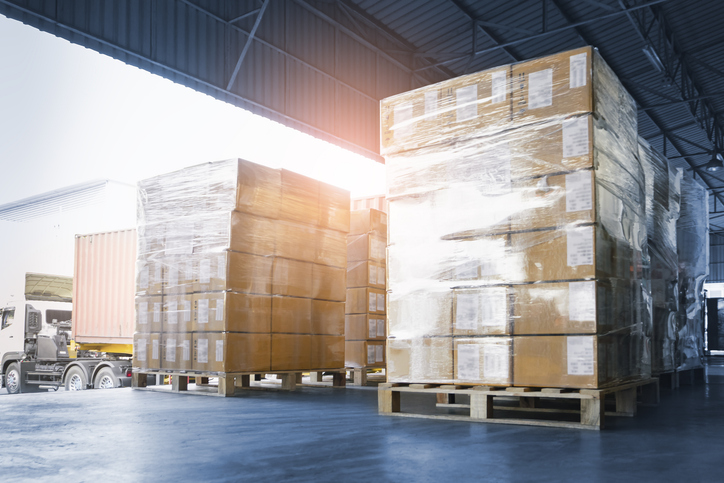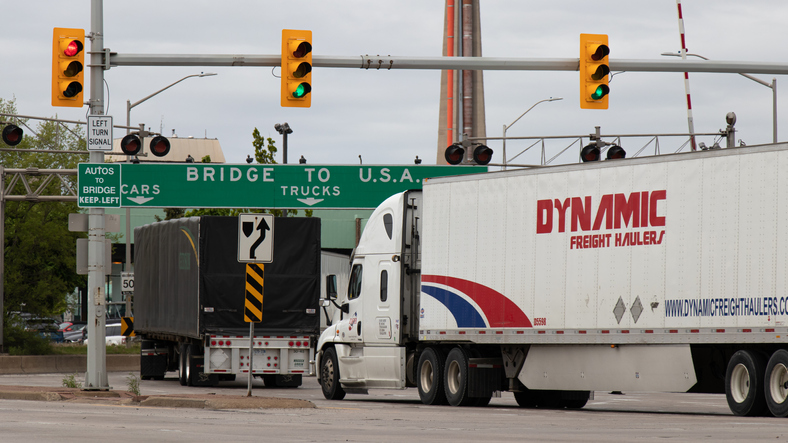In today's world of modern commerce, those working in the business sector often wonder: How does cross-docking contribute to improving efficiency in logistics operations?
Many warehouses use this logistics tool to minimize inventory holding costs and streamline the flow of goods quickly through the supply chain as part of their logistics strategy. Cross docking has emerged as a pivotal strategy, revolutionizing the traditional approach to warehousing and distribution by prioritizing speed and agility in the movement of goods. By minimizing storage needs and optimizing transportation processes, implementing a cross-docking system can also reduce warehouse organization costs by 30-35%, making it an essential component of a cost-effective logistics strategy.
How to Understand Cross Docking in Warehouse Logistics
Cross docking operations are a transformative practice in warehouse logistics that fundamentally alters the traditional approach to handling goods. A cross dock operates on the principle of facilitating the direct transfer of products from inbound to outbound dock shipments without the necessity of intermediate storage. This departure from conventional warehousing procedures brings about significant advantages in terms of operational efficiency, cost reduction, and overall supply chain optimization.
One of the primary benefits a cross dock facility has is its ability to streamline processes within the warehouse management system. By eliminating the need for storage, goods can move swiftly through the facility, minimizing handling time and reducing the risk of damage or loss. This efficiency gain translates into faster order fulfillment and enhanced customer satisfaction.
What are the Specific Types of Cross-docks?
In today's supply chains, where efficiency and flexibility are crucial, cross-docks work as a strategic tool to optimize warehouse operations. Understanding the different types of practices and their practical applications enables businesses to improve supply chain efficiency, reduce expenses, and enhance overall customer satisfaction.
- Pre-Distribution cross-dock
Pre-distribution involves the sorting and consolidation of incoming shipments before onward distribution. Upon arrival at the warehouse facility, products are immediately transferred to outbound transportation vehicles, bypassing storage. This is particularly beneficial for companies with high-volume, repetitive shipments, enabling rapid order processing and fulfillment.
- Post-Distribution cross-dock
Post-distribution occurs after goods have been received in the warehouse facility. Incoming shipments are quickly sorted and consolidated based on destination or customer orders, facilitating efficient outbound delivery. This approach is ideal for companies with diverse product lines or fluctuating demand patterns, allowing for dynamic order fulfillment while minimizing storage requirements.
Whether optimizing for speed, cost-efficiency, or inventory management, cross-docking offers a versatile solution for enhancing overall supply chain performance.
De-Consolidation vs. Consolidation Cross-Docking
In logistics, cross-docking strategies play a vital role in optimizing the supply chain. Two commonly used methods are de-consolidation and consolidation cross-docking, each designed to address specific distribution needs. Here's a breakdown of their processes and applications:
De-Consolidation Cross-Docking
- Process: Breaks down large inbound shipments into smaller loads for efficient distribution.
- Purpose: Handles diverse destinations, staggered delivery schedules, and reduces long-term storage.
- When Used: Ideal for shipments requiring varied destinations, flexible delivery timelines, and optimized inventory flow.
Consolidation Cross-Docking
- Process: Groups multiple smaller shipments into a single, larger outbound load.
- Purpose: Streamlines sorting and dispatch, especially for deliveries from multiple suppliers or locations.
- When Used: Effective for synchronizing deliveries from various suppliers and minimizing redundant handling.
Key Difference:
- De-consolidation focuses on breaking down shipments for flexibility and precision.
- Consolidation emphasizes combining shipments to streamline distribution.
Cross Docking Best Practices
Implementing practices within warehouse logistics demands meticulous planning and execution to realize their full potential. This involves a series of key steps and considerations to ensure seamless integration and optimal performance.
Step 1: Design facilities with a layout optimized for smooth flow of goods, minimizing handling and processing times.
Step 2: Utilize technology such as RFID, barcode scanning, and warehouse management systems to automate processes and enhance visibility.
Step 3: Choose locations strategically, considering proximity to suppliers, transportation hubs, and end customers for optimal efficiency.
Step 4: Establish strong communication channels with suppliers and carriers to ensure timely delivery of goods and seamless coordination throughout the supply chain.
Step 5: Standardize inbound and outbound processes to minimize bottlenecks and maximize throughput, improving overall efficiency.
Step 6: Provide comprehensive training to warehouse staff to ensure they are proficient in operations, handling equipment, and safety protocols.
Regularly monitor key performance indicators (KPIs) such as throughput, order accuracy, and on-time delivery, and implement continuous improvement initiatives to optimize operations.
Assessing Shipment Characteristics
Before implementing cross-docking, it's crucial to thoroughly evaluate the characteristics of inbound and outbound shipments. Factors such as product type, size, weight, and handling requirements play a significant role in determining the feasibility and efficiency of operations.
Let's dive deeper into how each factor affects operations:
- Different types of products may have varying requirements for handling and storage. Some products may be perishable and require special handling, while others may be fragile and need careful attention during transportation. Understanding the specific characteristics of each product type is essential for ensuring smooth operations.
- The size of products can impact how they are sorted, stored, and transported within the warehouse. Larger items may require more space and specialized equipment for handling, while smaller items may be easier to manage. Proper sizing considerations help optimize warehouse layout and workflow efficiency.
- The weight of products affects not only handling requirements but also safety considerations. Heavy items may require specific lifting equipment or safety protocols to prevent injuries to warehouse personnel. Additionally, weight considerations influence transportation requirements and capacity, impacting logistics planning and efficiency.
- Each product may have unique handling needs based on its characteristics, such as fragility, temperature sensitivity, or hazardous properties. Understanding these handling requirements is crucial for ensuring product integrity and safety throughout the process. Proper handling procedures help minimize the risk of damage or spoilage and ensure customer satisfaction.
Overall, considering these factors allows businesses to tailor their processes to the specific needs of their products, leading to improved efficiency, reduced costs, and enhanced customer service.
Optimizing Dock Scheduling
Dock scheduling optimization is paramount to reducing dwell times and maximizing throughput in operations. By strategically coordinating inbound and outbound shipments, businesses can minimize waiting times and improve dock utilization efficiency. Implementing advanced scheduling algorithms and real-time monitoring systems enables proactive management of dock activities, enhancing overall operational performance.
Real-Time Visibility
Real-time inventory visibility is critical for the success of cross-docking operations. It enables seamless coordination by providing up-to-the-minute data needed for efficient movement of goods within tight timeframes. This minimizes delays and reduces errors, such as stockouts or overstocking, which can disrupt operations.
With accurate inventory information, resources like labor and space can be optimized, ensuring smooth workflows and cost efficiency. Additionally, timely handling of shipments leads to prompt deliveries, boosting customer satisfaction and maintaining trust in the supply chain.
Managing Associated Risks
Despite its numerous benefits, implementing a cross-docking strategy can pose challenges that require careful navigation and proactive solutions.
Synchronization of Inbound and Outbound Shipments
Achieving synchronization between inbound and outbound shipments is essential for seamless operations. Delays or discrepancies in shipment arrivals can disrupt workflow and compromise efficiency. Implementing advanced tracking systems and predictive analytics enables proactive monitoring and adjustment of schedules to maintain synchronization.
Coordination among Stakeholders
Inadequate communication or alignment among departments, suppliers, and carriers can result in operational inefficiencies and delays. Instituting clear communication protocols, conducting regular performance reviews, and fostering cross-functional collaboration forums cultivate a culture of accountability and teamwork.
Potential Disruptions in Supply Chain Flow
Mitigating these risks requires robust contingency planning, proactive risk management strategies, and continuous process improvement initiatives. Implementing quality control measures, redundancy protocols, and disaster recovery plans ensures resilience and continuity in supply chain operations.
Environmental Sustainability in Cross-Docking Warehouse
Environmental sustainability is increasingly becoming a focal point across industries as businesses strive to reduce their ecological footprint. In this context, cross-docking warehouses play a pivotal role in promoting environmentally friendly practices within the logistics sector.
Reducing Carbon Footprints
As industries increasingly prioritize environmental sustainability, cross-docking emerges as a strategic solution to reduce carbon footprints and minimize ecological impacts. By facilitating direct transfers of goods from inbound to outbound shipments, it minimizes the need for storage, thereby reducing the energy consumption associated with traditional warehousing.
Minimizing Ecological Impacts
Additionally, the streamlined movement of goods within the facility results in fewer vehicle trips and lower fuel consumption, contributing to a decrease in greenhouse gas emissions. This reduction in transportation-related emissions aligns with broader efforts to mitigate the environmental impact of logistics operations and promote sustainable supply chain management practices.
Future Trends, Innovations, and Methods
Looking ahead, the future is marked by technological advancements and sustainability initiatives. Integration of IoT, AI, and blockchain promises real-time insights and reduced environmental impact.
As businesses embrace digital transformation, cross-docking remains pivotal for efficient and eco-friendly warehouse logistics.
Cross Docking Service Providers
Third-party logistics providers (3PLs) have become indispensable partners for businesses seeking efficient and cost-effective supply chain solutions. Many 3PLs recognize the significance of cross docking in enhancing logistics operations and offer it as a key service to shippers. These providers leverage their expertise and infrastructure to facilitate seamless logistics processes, enabling shippers to reduce handling and storage costs while accelerating the movement of goods through the supply chain. By outsourcing cross docking to capable 3PLs, shippers can benefit from optimized inventory management, improved order fulfillment, and enhanced overall supply chain efficiency and supply chain flexibility. Moreover, 3PLs often integrate cross docking into comprehensive logistics solutions, providing end-to-end support to meet the diverse needs of their clients across various industries. As a result, the availability of cross docking services through 3PLs continues to play a vital role in driving operational excellence and competitive advantage in today's dynamic business landscape.
Optimize Your Supply Chain with Effective Cross Docking Strategies with Visigistics
Cross-docking is a powerful strategy to enhance supply chain efficiency, minimize costs, and improve customer satisfaction. By understanding and implementing the right cross-docking techniques, businesses can stay ahead in today’s fast-paced logistics landscape.
Ready to transform your warehouse logistics and boost supply chain efficiency? With our expertise, we'll streamline your operations for success.
Contact Visigistics today for cross-docking strategies that fit your unique business needs.
Frequently Asked Questions
What is a cross docking warehouse?
A cross docking helps as a distribution center where goods are received from suppliers and directly transferred to outbound transportation vehicles, bypassing the need for storage. This process optimizes supply chain efficiency by reducing the need for warehouse storage and streamlining logistics operations.
How does cross docking work?
The process is by expediting the transfer of goods from inbound to outbound shipments without intermediate storage. Upon arrival, products are sorted, consolidated, and routed based on their final destination. This efficient process minimizes handling and storage costs while accelerating order fulfillment and delivery times.
What is an example of a cross docking product?
An example of a cross-docking product could be perishable goods, such as fresh produce or flowers, that require expedited handling to maintain freshness. These items are received from suppliers and quickly transferred to outbound trucks for immediate delivery to retailers or customers, minimizing the risk of spoilage and maximizing product quality.
When should cross-docking be used?
It should be used when there is a need to optimize supply chain efficiency, reduce inventory holding costs, and expedite order fulfillment. It is particularly beneficial for industries with fast-moving consumer goods, seasonal demand fluctuations, or time-sensitive delivery requirements.
What are the benefits?
The benefits include improved supply chain efficiency by reducing the need for warehouse storage, minimizing inventory holding costs, and streamlining logistics operations. Additionally, it enhances order fulfillment speed, reduces order cycle times, and enhances overall customer satisfaction by ensuring timely delivery of goods.
What are the downsides to using a cross dock?
The utilization of cross docks may introduce additional handling, increasing the risk of potential damage to goods during the transfer process.
We are looking for cross docking warehouses near Tacoma, WA. Can you help?
Yes. Visigistics has cross dock solutions near Tacoma, WA and many other cities. Contact us today for help.
We are looking for a Nashville, TN cross dock. Can you help?
Yes. Visigistics has cross dock solutions in Nashville, TN and many other cities. Contact us today to discuss your needs.
We are looking for cross docking in Chatanooga, Tennesee. Can you help?
Visigistics has cross dock solutions with partners all over the country. Contact us today to discuss your needs.
We are looking for a cross dock in Kansas City, MO. Can you help?
Yes. Visigistics has cross dock solutions with partners all over the country. Contact us today to discuss your needs.





